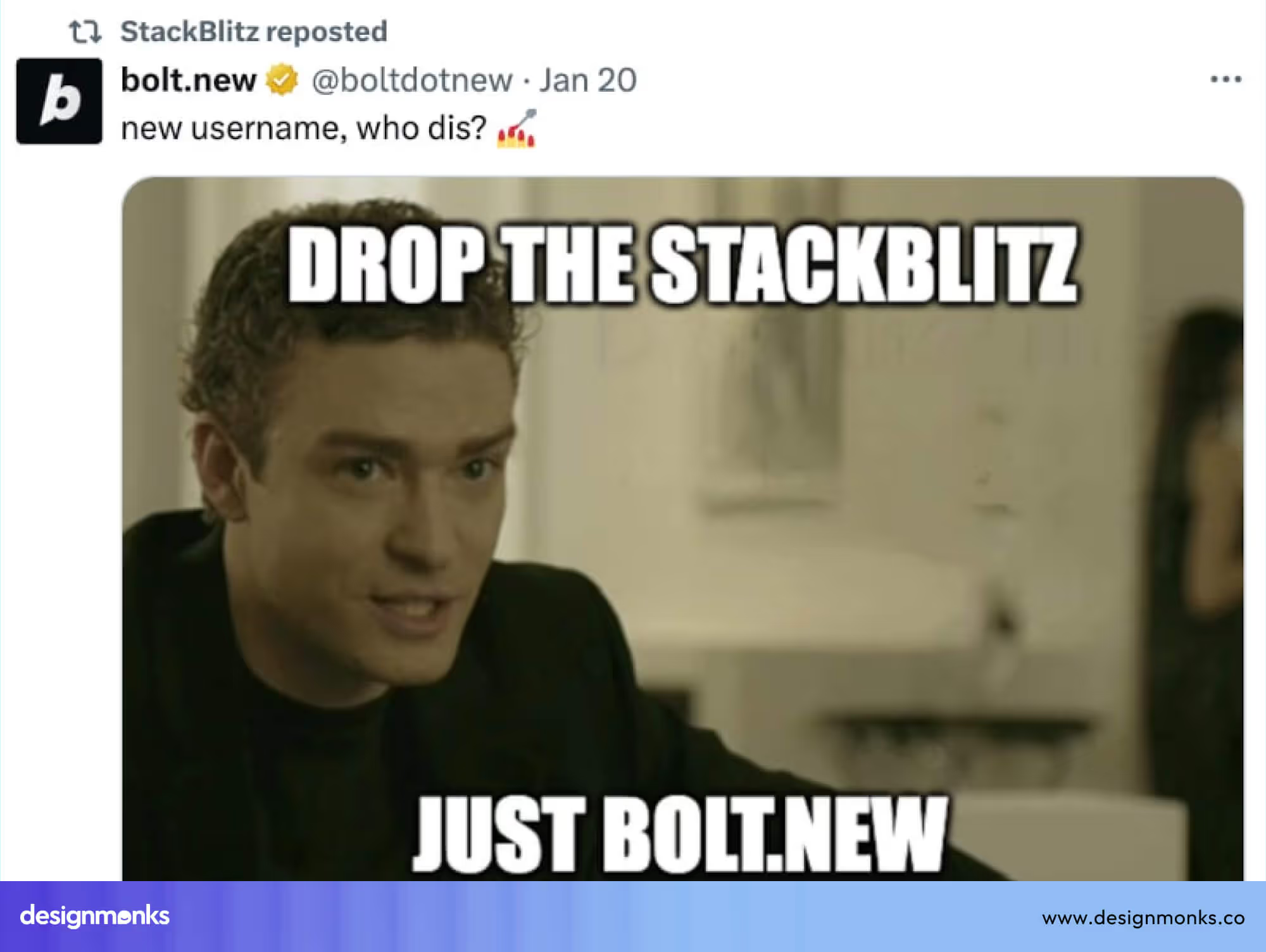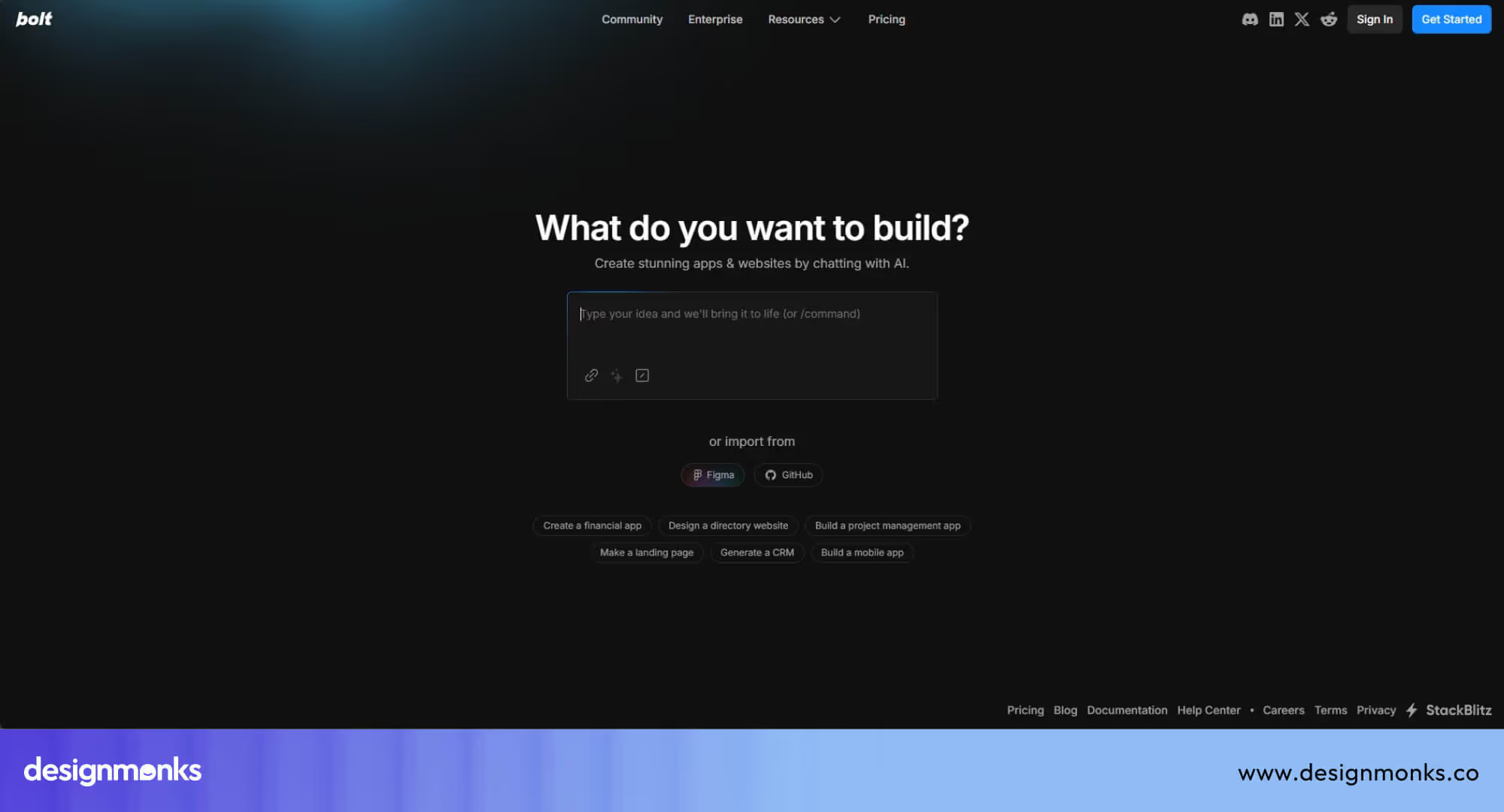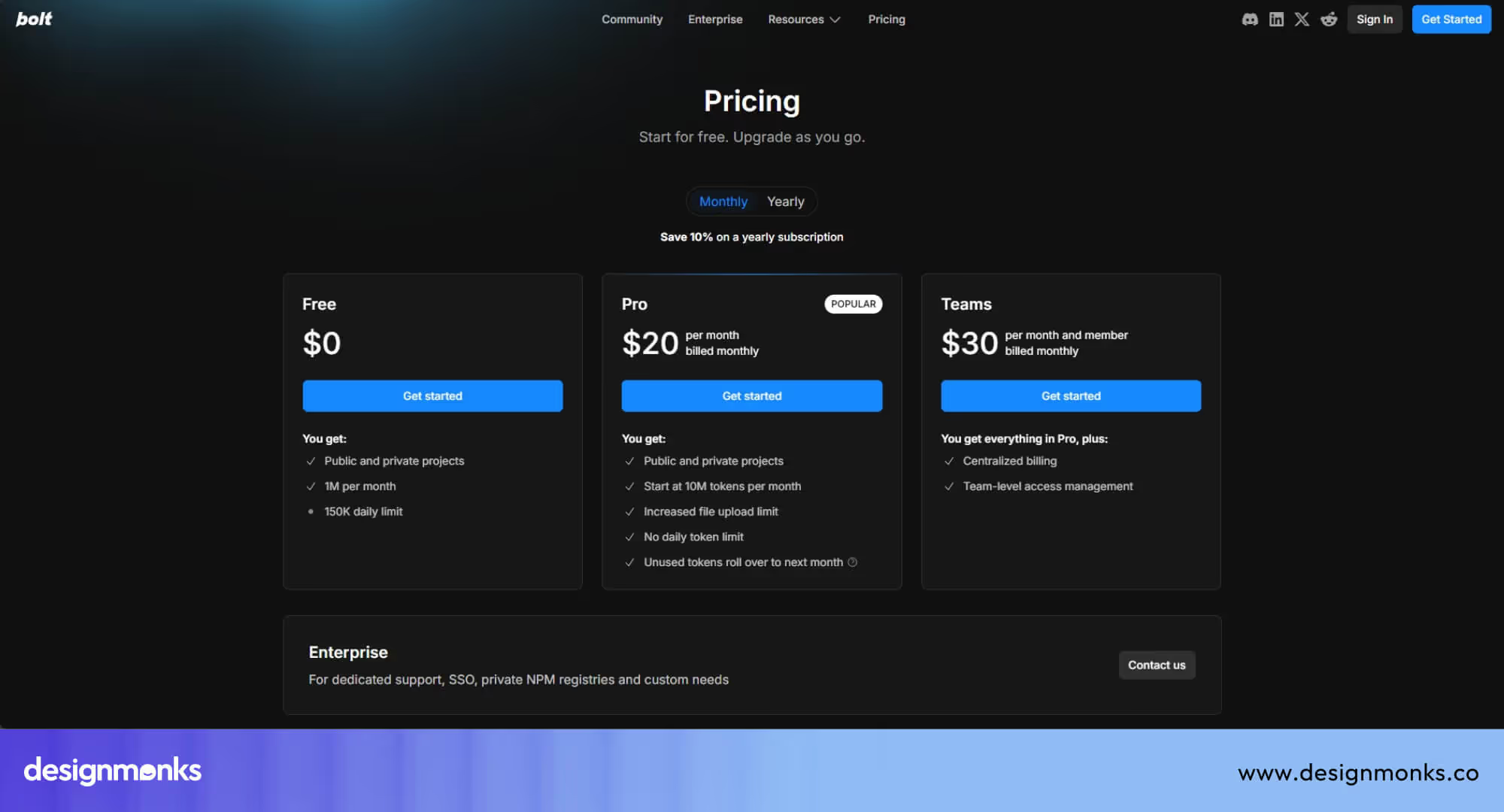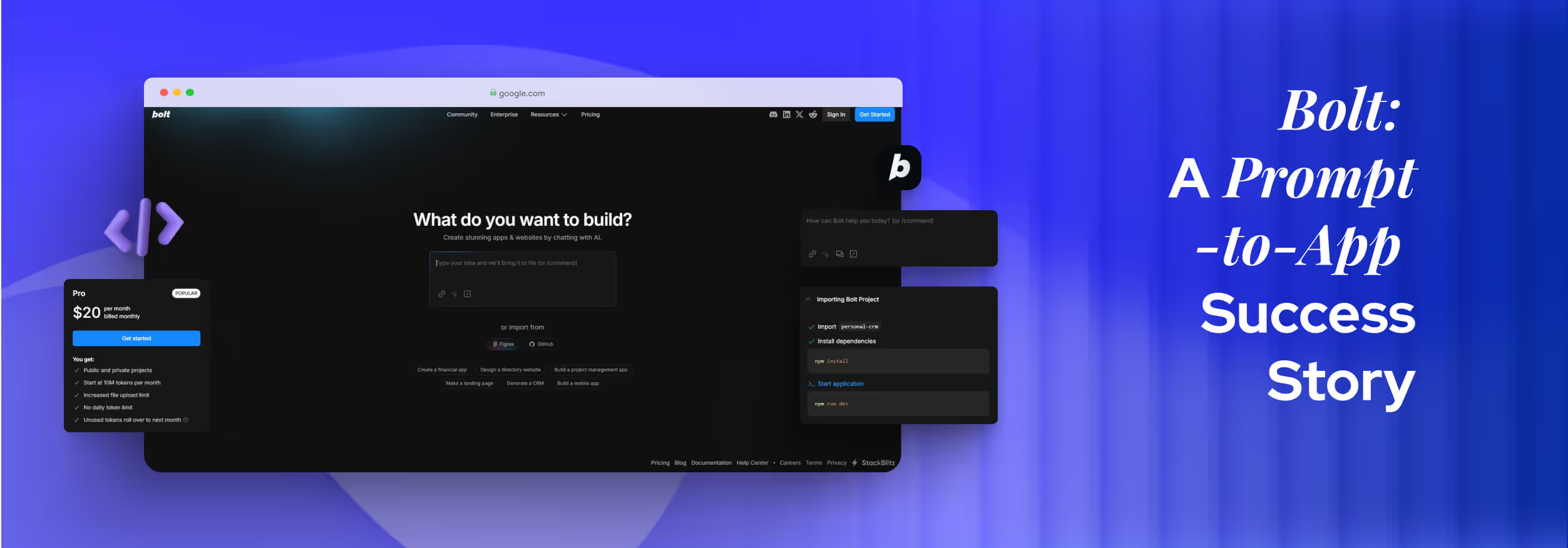What happens when a team struggles to move forward, hits a breaking point, but finds a solution in AI? You get Bolt, a tool that didn’t just survive, it rewrote the rulebook. This Bolt case study isn’t your typical startup tale. It’s about building apps with plain words and scaling faster than anyone saw coming.
Before Bolt, making software meant code, cash, and weeks of waiting. You had to know how to code or hire someone who did. Bolt changed that. Now, you open a browser, type a prompt, and get a working app. It’s that simple.
Want to know how that happened? Keep reading to find out how Bolt nearly shut down, made a bold move, and grew to $40M ARR in just six months.
Background & Challenges of Bolt
Bolt was built by the creators of StackBlitz, a platform that lets developers write and run code directly in their browser. Over seven years, the team behind StackBlitz developed a technology called WebContainers.
This is a system that runs full AI-assisted web development environments, including tools like Node.js, entirely in the browser. This meant faster workflows, no cloud servers, and lower costs.
Despite this innovation, StackBlitz faced serious challenges. By late 2023, Bolt AI revenue wasonly $80,000 in annual, which is unusually low for a company in the software development space.
Growth had stalled, user engagement was flat, and the future looked uncertain. Internal discussions even included the possibility of shutting the company down if things didn’t improve soon. The team realized that their technology had potential, but the product needed a new direction.

They needed a solution that would not only showcase the power of WebContainers but also offer clear value to a wider group of users, especially those outside the traditional developer audience. That’s when the idea for Bolt began to take shape.
Pivot & Innovation of Bolt
In mid-2024, the StackBlitz team made a bold move, they added AI to their platform. This shift marked a major turning point. They integrated Claude Sonnet 3.5, a powerful language model developed by Anthropic.

This addition gave their product a completely new ability. It can now understand plain English prompts and turn them into full working apps. With this upgrade, users no longer needed to write code manually.

They could simply describe what they wanted, like “Create a to-do list with a save button,” and Bolt would build the entire app, including the interface and backend. This new approach opened the door for both developers and non-developers to build software much faster and with less effort.
The new product, called Bolt.new, officially launched on October 4, 2024. There was no big campaign, no press release, just a single tweet announcing its release. But the simplicity of the idea and the power of the tool caught attention fast.
This quiet launch was the beginning of something much bigger than the team expected. Bolt was no longer just a browser-based development tool, it was becoming a whole new way to build apps.
Technology & Differentiation of Bolt
Bolt isn’t just another tool that uses AI, it’s built with smart technology that makes it different from the rest. One of its main features is WebContainers. This tool was created by the team over many years.
It lets you run programs such as Node.js right inside your web browser. As a result, you don’t have to wait for a cloud server or install anything big. It works quickly, right in your browser, like opening a regular website.
Moreover, the AI Prompt Engine of Bolt lets you type what you want in plain English, instead of writing lines of code. AI understands what you mean and builds the app for you. It creates both the front-end (what you see and click on) and the back-end (what happens behind the scenes to make it work).
Bolt also helps you make mobile apps using a tool called Expo. Once your app is ready, you can scan a QR code and see it right away on your phone. This makes testing and sharing easy and fast
Bolt’s Go-to-Market & Pricing
When Bolt first started, it made things easy for everyone by charging just $9 each month to use its app. This was a good deal for people who wanted to try it out or use it for fun. But soon, Bolt noticed a problem.
Bolt uses artificial intelligence (AI), which helps people build apps more easily. To use this AI, you need tokens. Tokens are small pieces of text or data that the AI reads and processes each time you type or ask it to do something.
The more you use the AI (when you build bigger or more complicated apps), the more tokens you use up. Some users were creating very large projects, which meant they used millions of tokens very quickly.
This caused problems for Bolt because handling so many tokens at once made it expensive to run the computers.

To fix this, Bolt changed the way it charged people. Instead of just one price for everyone, they made different plans. Now, you can choose a plan that fits how much you use Bolt.
Notable Pricing Highlights
- Start free, pay as you grow: Ideal for testing before commitment.
- Token rollover: Unused tokens carry over in paid plans (Pro & Teams).
- Branding control: Remove the Bolt watermark in paid tiers.
- Custom domain + SEO perks for Pro and above.
- Centralized billing & team management in the Teams plan.
- Enterprise-grade features: SSO, compliance, dedicated manager, and training support.
- 10% discount when billed yearly.
Growth & Adoption of Bolt
Bolt launched in October 2024, and it didn’t take long to become a huge success. In just 30 days, it went from making no money at all to reaching $4 million in yearly income. Their older tool, StackBlitz, used to earn $4 million in a full year. Bolt was now making the same amount every month.
The platform continued growing fast. By December 2024, it had reached $20 million in yearly earnings, and by March 2025, it was bringing in $40 million per year. This kind of rapid growth clearly showed that people liked what Bolt had to offer.
Moreover, Bolt’s number of users grew quickly, too. By March 2025, about 5 million people had signed up to use it. These users are called “software composers” because they create software just by describing what they want.
The website was also getting a lot of attention. In May 2025, Bolt’s site had over 9 million visits, and each person stayed for about 22 minutes on average. This shows that people weren’t just checking it out, they were actually using the tool to build things.
At the same time, Bolt also became well-known around the world. It was ranked among the top 6,800 websites globally. It became especially popular in countries like India, the United States, and Brazil.
With its AI prompt update, Bolt gave people an easy way to build apps. All they had to do was type what they wanted in plain English, and Bolt did the hard work. No complicated coding. No long setup. It's just fast, simple software creation, that's what made it stand out.
Customer Stories of Bolt
One of the best ways to understand Bolt’s power is through the stories of everyday people who’ve used it to turn ideas into real, working apps.
Across social platforms like Reddit and X (formerly Twitter), users have shared how Bolt helped them start businesses without needing to know how to code:
1. From 8 Months to 8 Weeks: A SaaS Built on Bolt
One user on Reddit wanted to build a software business(SaaS) that customers could use online. A contractor told them it would take 8 months and cost around $19,000 to get it done. That was way too much.
Instead, the user tried Bolt. By simply describing what they needed in plain language, they built the app in just 8 weeks. Not only was it finished faster, but the app also started earning them $3,700 per month. This story shows how Bolt helps people skip long timelines and high costs.
2. Pashu E‑Chaara: Helping Farmers Order Animal Feed Online
A business owner wanted to help farmers feed their animals without having to travel or make phone calls. With Bolt, they built Pashu E‑Chaara, an online platform where farmers can browse, order, and pay for feed using their phones.
They also used tools like:
- Supabase: To keep track of customer data
- Node and Express: To help the app run in the background
- Stripe: To safely handle online payments
Everything was built in just a few months, and now farmers can place orders easily, saving time and effort.
3. DairyFertilo: Turning Waste into Organic Fertilizer
In another project, the founder of DairyFertilo wanted to help dairy farmers turn cow waste into natural fertilizer. They needed an app where farmers could schedule pickups, track how much waste was collected, and even view reports.
Using Bolt, they built a full app that works on mobile devices. Just like the other example, they used Supabase for data and Stripe for payments. What would have cost thousands and taken months was done quickly and without any coding skills.
Bolt’s Pain Points & Critiques
While Bolt has grown quickly and impressed many with its ease of use, it’s not without its challenges. As with any powerful new platform, users have pointed out areas that still need improvement.

1. High Token Consumption and Cost Management
Bolt’s AI system depends on tokens (the units it uses to process and understand user input). Some users have noted that Bolt burns through a large number of tokens quickly, especially during longer or more complex builds.
This can lead to unexpectedly high usage and costs, especially for frequent users or those experimenting with multiple project versions. Managing token usage more efficiently is a key area where users hope to see improvement.
2. Recurring Bugs and Stability Concerns
Although Bolt helps people build apps fast, some users have reported seeing the same bugs reappear across different projects. Even after those issues were fixed in earlier versions, they sometimes return when the app is rebuilt or modified.

This raises concerns about code consistency and platform stability, especially for users who rely on Bolt for business-critical tools.
3. Lack of Version Control Tools
Unlike traditional development platforms, where you can track changes and roll back updates, Bolt currently lacks full version control support.
That means if the AI changes something you didn’t expect or if something breaks, it’s hard to go back to an earlier working version. This can be frustrating for users working on more complex apps or trying to collaborate with others.
4. Rising Costs for Power Users
Although Bolt makes it easy to start building for free or at a low cost, the price can increase quickly as you scale up.
Users who build more advanced apps or who rely heavily on backend functions, integrations, or AI prompts often see their monthly bills grow beyond their original expectations.
The pricing model may feel unpredictable for those who aren't familiar with how usage is measured.
5. Limited Control Over AI Output
Bolt’s AI handles most of the code behind the scenes. While that makes things faster for beginners, it also means users don’t always understand what the code is doing or have full control over it.
For users who want to fine-tune their apps, this can feel limiting. In some cases, the AI may also make changes the user didn’t ask for, leading to extra revisions or confusion.
Bolt.new Performance Benchmarks (2025 Testing)
To objectively evaluate the software company Bolt on AI app builder capabilities, we conducted systematic testing across different project complexities throughout early 2025. Our analysis reveals significant performance variations based on application scope and iteration depth.
Build Time & Token Consumption
Build Time & Token ConsumptionRapid Prototyping Excels
Simple applications with 3-5 components generate functional code within minutes. Initial scaffolding consistently meets expectations with minimal debugging required.
Mid-Complexity Ceiling
Once projects exceed 15-20 components or require custom API integrations, context retention degrades noticeably. Token consumption accelerates during debugging cycles, often doubling initial estimates.
Scaling Limitations
Applications requiring complex state management, authentication flows, or third-party service orchestration push Bolt beyond its reliability threshold. Our testing showed success rates plummet to 31% for enterprise-grade features.
Cost Reality Check
A moderately complex dashboard consumed 85,000 tokens across iterations, equivalent to $42-85 depending on your plan tier. Monthly token pools (typically 50,000-100,000) deplete faster than marketing materials suggest, especially when troubleshooting architectural issues rather than adding features.
Bolt.new vs Bubble vs Replit vs Lovable (2025 Comparison)
Choosing the right AI-powered or no-code builder depends on your technical skills, project complexity, and budget constraints. Here's how these platforms stack up.
Feature Comparison Table
Feature Comparison TableCode Generation vs Visual Building
Bolt, Lovable, and Replit use AI to Production-ready code generation from natural language prompts, giving developers full access to modify, export, and deploy anywhere. This approach excels for technical users who want speed without sacrificing control.
Bubble, conversely, uses a visual drag-and-drop interface with proprietary logic, perfect for non-coders, but creating dependency on the platform.
Pricing Transparency and Predictability
Token-based pricing in Bolt and Lovable creates unpredictability, and debugging sessions can drain monthly allocations quickly, with costs spiking to $100+ for complex projects.
Replit's flat subscription ($7-30/month) offers better cost control for ongoing development. Bubble's tiered pricing ($29-349/month) is transparent but expensive, though it includes hosting, database, and infrastructure costs that others charge separately.
Production Scalability
Bubble leads significantly in production-ready capabilities, with a proven track record of startups scaling to thousands of users on the platform. Bolt and Lovable struggle with complex applications, requiring manual code refactoring and migration to traditional development environments.
Replit sits in the middle, capable of hosting production apps but requiring more developer expertise to optimize performance and security.
When Context Retention Matters
Bolt and Lovable both suffer from context loss after 15-20 iterations, frequently introducing bugs when modifying existing features. Replit's Ghostwriter AI maintains better context through collaborative coding sessions but requires more manual intervention.
Bubble eliminates this issue entirely; visual elements persist perfectly since there's no AI interpretation layer.
Integration Ecosystem
Replit wins for developer tools with native GitHub sync, package managers, and terminal access. Bolt offers decent integrations (Stripe, Supabase, GitHub) but requires manual configuration.
Lovable has similar capabilities with slightly better database handling. Bubble provides 1,000+ plugin marketplace integrations, but many require paid add-ons, increasing the total cost.
Team Collaboration Features
Replit and Bubble excel in multi-user environments with real-time collaboration, commenting, and version control.
Bolt and Lovable are primarily solo-developer tools, sharing projects requires exporting code and using external Git repositories. For agencies or product teams, this limitation significantly impacts workflow efficiency.
Which Platform Should You Choose?
Choose Bolt.new if:
- You're a developer needing rapid MVP prototypes.
- You want code ownership without vendor lock-in.
- Projects are relatively simple (under 20 components).
- You can handle manual debugging and deployment.
Choose Lovable if:
- Similar to Bolt but prefer slightly better database tooling.
- You prioritize React-specific applications.
- You're willing to trade similar limitations for marginal UI improvements.
Choose Replit if:
- You need collaborative coding environments.
- Predictable monthly costs matter more than speed.
- You want traditional development with AI assistance.
- Production hosting on their infrastructure works for you.
Choose Bubble if:
- You're non-technical but need production-grade apps.
- Budget allows $50-350/month ongoing costs.
- You prioritize stability over code ownership.
- Mobile app wrappers and visual workflows suit your needs.
Future Outlook of Bolt
The team behind Bolt isn’t slowing down. They have a big goal to grow the company and reach $100 million in yearly earnings.
And they’re already taking steps to make that happen. They’ve added several new features to make Bolt even better:

Claude 3.7: This is a new and smarter type of artificial intelligence (AI). It helps make app-building faster and easier by giving better suggestions and doing more of the hard work for you.
Figma Integration: Figma is a design tool where people create app layouts and screen designs. Now, you can turn those designs into real, working apps inside Bolt.
Visual Inspector: This tool lets you look at your app and quickly spot problems. You don’t need to go through the code. This tool will guide you through it.
Mobile Debugging Tools: These tools help you test your app on real phones or tablets. You can find out if something is not working and fix it before sharing the app with others.
GitHub Support: GitHub is a tool that helps people save their work, keep track of changes, and work with others on the same project. Now, Bolt works well with GitHub too.
Thanks to these updates, Bolt is now great for both beginners and experienced app makers. It’s simple for new users, but powerful enough for teams building bigger and more complicated apps. Bolt is growing fast, and the future looks bright!
Key Takeaways
Bolt’s journey offers some clear lessons about building a modern tech product, especially one powered by AI. Its rapid rise wasn’t just luck, it was the result of smart decisions, great timing, and a strong community.
1. Timing Made a Big Difference
Bolt launched at the perfect moment, right when interest in AI tools was taking off. People were excited about using artificial intelligence for everyday work, and Bolt gave them a way to build real apps using just words. That early launch gave Bolt a big advantage.
2. Simplicity Attracts More Users
One of Bolt’s biggest strengths is how easy it is to use. You don’t need to be a programmer or have any technical background to get started. By removing that barrier, Bolt made software development possible for millions of people who never thought they could build apps before.
3. Usage-Based Pricing Works for Everyone
Bolt’s pricing depends on how much you use it. That means casual users can try it without spending a lot, while power users who build full apps can pay more for extra features. This system keeps it fair and flexible for different types of users.
4. Community Over Advertising
Bolt didn’t rely on big ad campaigns to grow. Instead, it became popular because users shared their results on platforms like Reddit and Discord. People posted about what they built, and others got inspired to try it themselves. That kind of word-of-mouth marketing turned out to be very powerful.
5. Growth Comes with New Challenges
Even with all its success, Bolt still has work to do. Users have asked for improvements like fewer bugs, better version control (so they can track changes), and smarter use of tokens to avoid high costs. If Bolt wants to stay on top, it needs to keep improving and supporting more advanced needs.
Final Thoughts
Bolt is changing the way people bring their app ideas to life. What used to take months and a big budget can now happen in days, with no coding needed. While it’s not flawless and still growing, Bolt gives everyday users the power to build real, working apps from their browser.
If you’ve ever dreamed of launching your own app but didn’t know how to begin, Bolt could be the simple and smart place to start.

.svg)








.avif)



